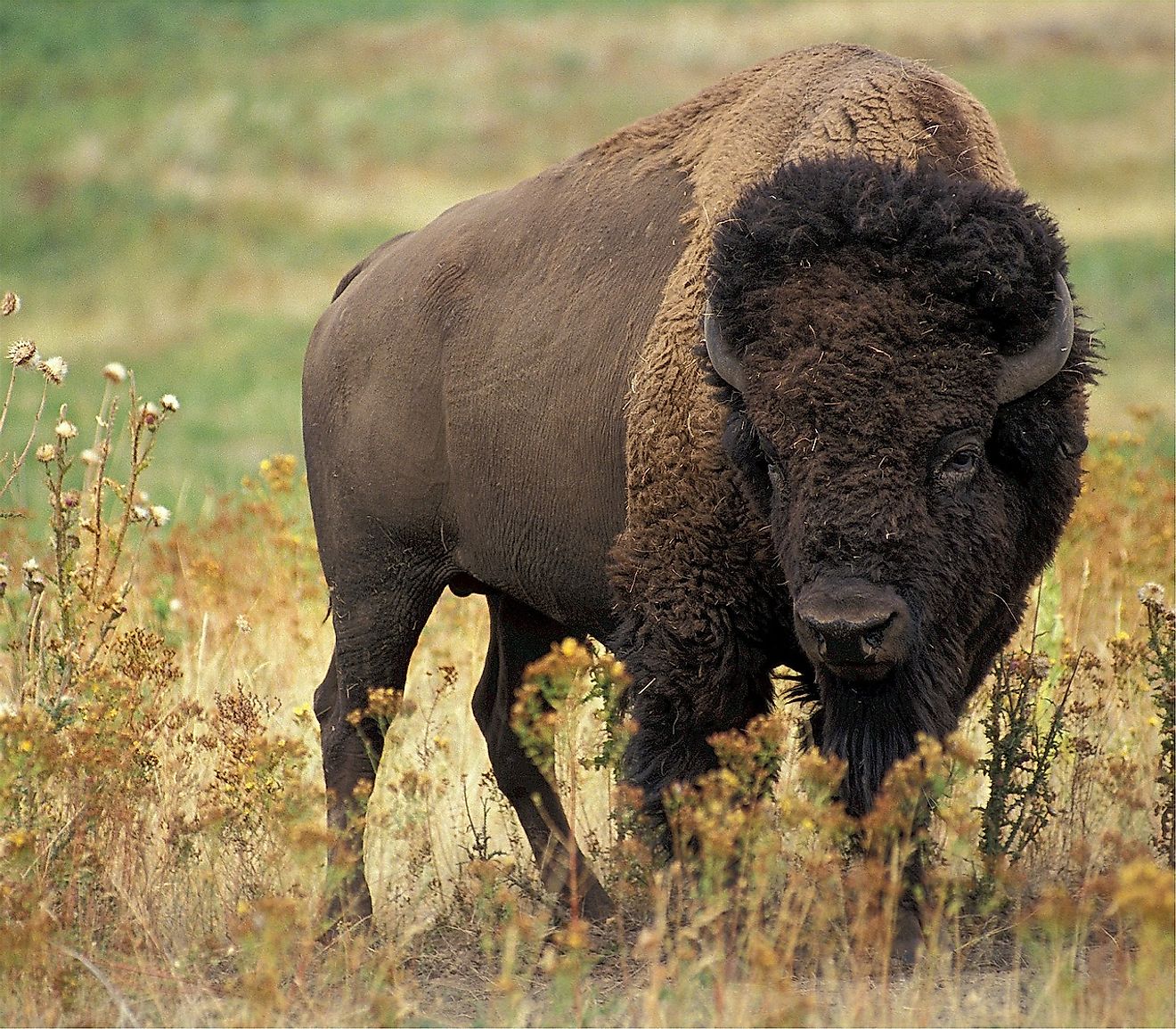Bison Facts: Animals Of North America

6. Physical Description
The American bison (Bison bison), or buffalo, is considered to be the largest terrestrial animal living in North America today. A male buffalo can grow as high as six feet, as measured from its hoof to shoulder. These ‘bulls’ can weigh between 1,000 and 2,000 pounds. On the other hand, a typical female bison (a ‘cow’) can reach five feet in height, and can weigh between 800 and 1,000 pounds. An American bison’s fur is brown, long and shaggy, and its chin has a beard and mane underneath. Its long tail has a distinctive clump of hair at its end. The animal’s head is very large, with two short black horns, and bison possess a large hump on their shoulders.
5. Diet
Despite its fearsome look, the American Bison is an obligate herbivore. They are prolific grazers, commonly dining on a wide variety of grasses, herbs, and sedges. Sometimes, they are seen eating berries and lichen as well. They regurgitate their food and then chew it as cud before finally ingesting it, as do other ruminant mammals. During winter, the bison clear off the snow to reach vegetation with the help of their large heads and tough hooves.
4. Habitat and Range
The American bison can be found living in the plains, river valleys, and prairies across much of North America. They migrate together in groups known as herds. They once lived in large numbers on the Great Plains of North America, and were very important to the Native American societies who utilized every part of their carcasses for food, clothing, tools, storage vessels, and shelter materials alike. Unfortunately, about 50 million buffalos were killed for sport, fur, and food in the centuries following European colonization into their native range, thereby denying the Native Americans therein of their most significant sources of food and most other necessities of daily life. For this reason, the numbers of bison were quickly diminished to only several hundred-strong. At present, they have slightly rebounded, and about 200,000 bison are alive, scattered across ranches and wildlife preserves. Many bison are raised on large scales for their commercially viable meat-producing prospects. Hybrid crosses between American bison and cattle are referred to as beefalo, while hybrids of cattle and European Bison, or wisents, are called “zubron”.
3. Behavior
An American bison rests during warms hours of the day, chewing its cud or wallowing in mud and dirt. It is often very active during early morning hours and in the late afternoon when temperatures are colder but light is still present. Bison herds are not uniform, and different areas’ respective populations may be comprised of starkly different groupings. Such contrasting groups could be seen in a mixed group of 20 females and young males in one area, while an all-male group of up to 20 can also live together nearby. More commonly, however, adult males and females generally remain separated except during breeding season. Each group of male bison will be led by an alpha male, while a dominant female will lead a single-gendered group of cows.
2. Reproduction
Once a female bison reaches between two and three years of age, they will be prepared to mate. Males, on the other hand, may not ready to mate until as late as when they turn six years old. The mating season of bison starts in July and ends in September. During the season of mating, male bison will follow female groups and pick a mating partner after which the males "tend" their selected females. A male tends a female by remaining between the female and the rest of her herd. This stage may last for as little as a few minutes to as long as several days. If the female doesn’t want to mate with the male, she will abandon him. Males will intimidate and sometimes hurt other males that attempt to get close to a female that is currently being tended. Fighting in male bison may involve locking horns, head-butting, and shoving. Around nine months after successfully breeding, a female bison will usually give birth to one single calf, and she will stay in an isolated area to give birth. A newborn calf is reddish brown in color, and they can quickly stand after their birth, and a mother and her baby will remain completely isolated for several days thereafter. Within two months, a calf will develop its horns and shoulder humps and, by its seventh month, a calf will generally be weaned.
1. Threats
The main threat to bison are unmistakably irresponsible humans. Through a variety of indirect and direct ways, human activities that occur in bisons’ home ranges often don’t allow them live as a wild animal, and go about their vital, natural roles within their grassland environments. Though there’s little chance that bison will reach extinction due to widespread ranching and animal preserve measures, they are considered “ecologically extinct”, in that virtually no American bison today live uninhibited by human activities on open ranges today. Most of their known stomping lands are already off limits because of opposition from livestock producers. Sadly, it would seem that the days of large herds of wild bison roaming the North American Great Plains are now gone.











